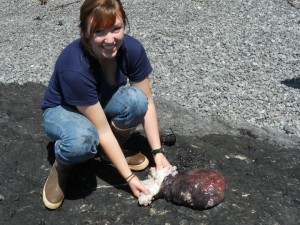Tonight is the culmination of weeks of intense planning, continuous revision, and slaving research. I’m procrastinating on a final paper!
So, instead of working on it, I think I’ll tell you about it.
After birth and before adulthood comes the volatile stage known as “the juvenile”. Actually, in congruence with the parts of speech elsewhere in that list it should be “adolescence”, but I want to talk about the individual noun, not the collective one. So, “juvenile”. For me, the word ‘juvenile’ conjures up images of angry preteens wearing bright orange jump suits and screaming obscenities into a darting camera, presumably directed at their mothers for sending them to a national talk show “boot camp” to attenuate their prepubescent temper tantrums. Fortunately, these are not my research subjects.
Instead I am working with juvenile clams, clad in shiny 1-3 mm shells and darting in and out of focus under my dissecting microscope.
My research question is pretty basic: where are the baby clams (I will henceforth use baby and juvenile interchanegably for the sake of syntactical and lexical variation)? Thus, with a spoon and some urine sample cups, I set off to do science!
I collected sediment samples from 7 sites around San Juan Island, generally in adjacent pairs for comparison based on sediment composition, wave exposure, and beach grade. I sampled different tidal heights, or distances up the beach, which required some fancy dancy surveying equipment, including a laser level and telescoping jumbo-ruler with BEEPING signal receiver. I caused quite a ruckus in the intertidal.
After filling my countless cups of mud, like any good scientist, I ‘returned to the lab for analysis’. Namely, sieving sediment for minuscule molluscs on a 1-mm wire mesh. I know you humanities majors don’t have much of a concept of what a millimeter looks like, so just imagine the smallest Nerd you can find in a box of the Wonka candy, and you’re about there. And that was about the size clam I was looking for. I spent many hours with my face in the sieve staring down every piece of sand and granule in those samples until a few revealed their true identity as clams. Needless to say, I was not very good at human interaction after mornings with the sieve, but I found a junk-ton of clams and got a pretty good tan on (one arm and half) my face during those few sunny weeks of fieldwork.
Our time for completing this project was relatively brief and many of our schedules were ruled by the tide. As a result, coordinating transportation for 14 students to about 14 fieldsites meant that my profs had to get creative. Thus, came those five frightening words:
“Can you drive stick shift?”
“Uhh, sure?” [I think I can drive stick shift…]
“It would really help if I could just lend you my car for the low tide, and I trust you to take it.” [Yeah, I can totally drive stick shift!]
It’s amazing how one’s beliefs can evolve over the course of a single conversation with a superior whose approval you sincerely seek.
Don’t worry, the car and I made it safely to and from our destination with only some minor embarrassment at mid-town stop signs.
All in all, my project was a success and I am working on establishing some guidelines for predicting where one might find baby clams (which is of interest to the REU student taking my place on this project for the summer) and further investigating the role of the juvenile stage in determining adult distribution and abundance.
In related news, I saw some whales. During a lovely visit from fellow Loggers, Grace Ferrara, Laura Strong, Andrea Leiken, and Prof Joel Elliott, I took the new-comers for a little sight-seeing at Lime Kiln lighthouse to watch the sunset, and along came a few transient orcas. To add to the show, a harbor seal played peak-a-boo with us from the water below our rock-shelf seats. Overcome by the harmony of the natural world in this menagerie of beauty, I, of course, got out my cell phone to take a picture. I sent a heart-felt 1.2 mb of sunset to a friend on the other side of the country, and then my phone said, “Thanks for sending a message from CANADA! You will be harshly financially punished for this display of frivolous international travel.” And I’m like, “wha? 1. I don’t remember leaving the country. 2. That was a weird message.”
Well, it probably wasn’t worded exactly like that, but it was a bluff anyway. Many places in the San Juans are often subject to Canadian airwaves, including radio stations in French, and fraudulent international cell phone charges. Often enough that most carriers just ignore you while you’re up here.
To explain the many black-background-ed photos presented here, I should tell you I went nightlighting, yet again. Our most exciting find this time was the strip of refractive something pictured in the last five photos. When I first saw it I, naturally, assumed it was a tiny living glow-stick. Turns out it is actually probably just a single cten, or row of cilia, from a ctenophore. On a whole animal, the ctens ripple in rainbow-flashes of coordination that propel the ctenophore forward. Ocean magic.








